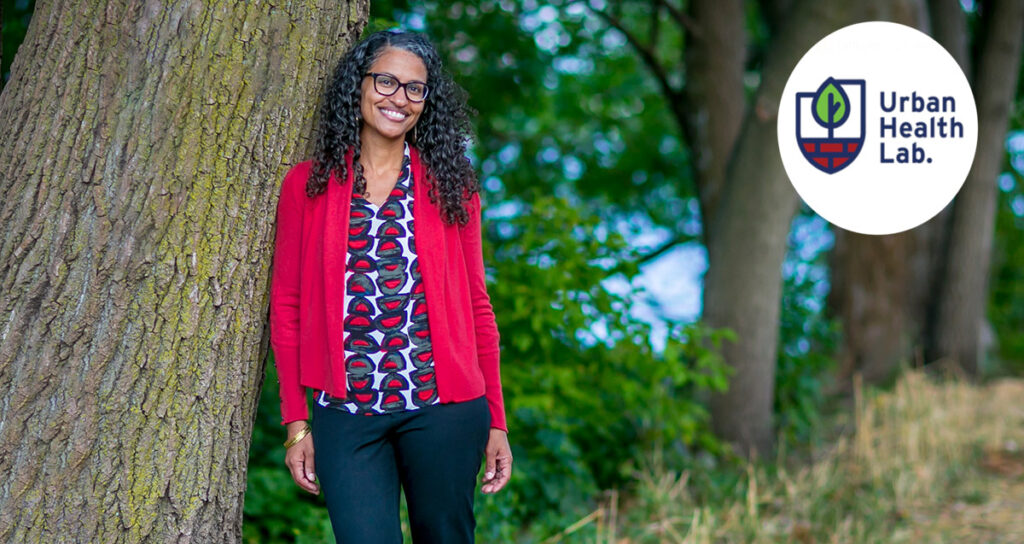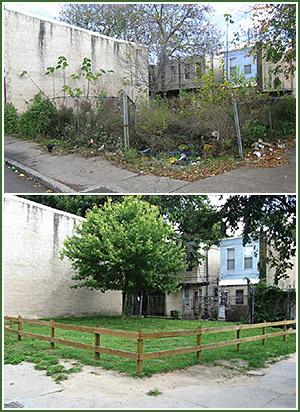Health Equity | Population Health
News
New Director, New Vision at Penn Urban Health Lab
Eugenia South Plans More Action and Policy Focus with Enhanced Emphasis on Structural Racism

The new Director of the University of Pennsylvania Urban Health Lab Eugenia South, MD, MSHP, a protégé of former Penn Professor Charles Branas, is now taking over the research facility he created in 2013.
Taking charge of a major university research center for the first time is always a challenge; taking charge of a center focused on urban health as the COVID-19 pandemic cuts its deadly swath across urban communities is something else completely, but Eugenia South has no doubt she is up to it.
South, MD, MSHP, is the new Director of the Penn Urban Health Lab, an Assistant Professor of Emergency Medicine at the Perelman School of Medicine, and an LDI Senior Fellow. Additionally, she is a member of the newly-formed University of Pennsylvania Bold Solutions research initiative aimed at finding evidence-based solutions to problems of institutional, structural, and interpersonal racism that impact health.
Also Vice Chair for Inclusion, Diversity, and Equity for the Department of Emergency Medicine, South is planning to expand the Urban Health Lab’s focus in ways that closely match the Bold Solutions’ effort.
Disproportional impact
“Just seeing the impact of COVID-19 as it disproportionately impacts Black and Latino communities has doubled down my personal commitment to work in every way that I can within academia to push for equitable change in health and wellbeing,” she said.
The seven-year-old Urban Health Lab’s past research has focused on testing neighborhood environmental interventions targeting blight remediation, housing repair, green spaces, and violence that directly impacts community health throughout the city’s poorest neighborhoods.
The six main research areas the Lab will focus on as South begins her tenure are Urban Nature, Blight Remediation, Community Violence, Noise Pollution, Housing Quality, and Structural Racism.
Structural racism research
“As I take over the Lab, I want to look at structural racism in a more organized manner,” South said. “Much of what the Lab has been studying since it opened has been around neighborhood issues rooted in the history of structural racism, but I want to make ‘structural racism’ a named area of study. The evidence base for structural racism interventions is pretty thin at the present time and one of my long-term goals is to broaden that base of evidence.”
Racism is a root cause underlying widespread disparities in social, economic, and health outcomes, including the ability to stay alive. Yet, the insidious and pervasive nature of racism, along with the uncomfortable recognition that some groups benefit from how society is currently organized, make it a challenging and complex problem… Accountability should be a guiding principle of creating a culture of antiracism. Clear metrics of success for all initiatives should be determined, and transparent reporting to institutional leaders is vital.
Eugenia South
In a July edition of The Journal of Clinical Investigation, South teamed up with Penn Medicine colleagues Raina Merchant, MD, MS, and Paris Butler, MD, MPH, to author an article about the issue:
The Penn Urban Health Lab was originally created by a research team led by then-Penn Professor Charles Branas, PhD. It was a hub for investigating how variations in urban landscapes influenced community health.
In 2010, when South began two years of studies in Penn’s Master of Science in Health Policy Research (MSHP) program, she was paired with Branas as her mentor. She continued as a member of his research team when he opened his new Urban Health Lab.

The Branas team’s work made national and international news. For instance, it undertook the first citywide randomized controlled trials to transform vacant lots and abandoned buildings as sustainable solutions to improving neighborhood health and safety, including reductions in gun violence. It turned the rising issue of “greening” inner city neighborhoods into a regional and national news story that brought new attention to how the physical environments of under-resourced neighborhoods influenced the health and behavior of residents.
And it set South on the unexpected path to becoming a scientific guru of greening.
Greening evidence base
“As I was getting into vacant lot greening with Dr. Branas and trying to figure out what it is about this intervention that impacts health and safety, I started to learn more about the evidence base around nature and health,” said South. “I became convinced by the evidence and my own work that nature is truly an underutilized community health tool.”
By “nature,” she means the kind of exposure to nature you get when spending time amid the trees and shrubbery of a local park or other natural area.
Prescribing nature
ParkRx, a national association of health and social service providers that advocates the official prescribing of “nature” to patients who require it, says there are more than 400 studies showing an association between exposure to nature and specific health benefits.
South, who is not connected to ParkRx, generally agrees with that. “The evidence base behind the benefits of nature exposure and mental health is pretty big,” she said. “There’s evidence for benefit with physical health problems like hypertension and diabetes. There’s a bunch of associational studies showing relationships between living near, or spending time in, green space and an impact on blood pressure and diabetes. Other studies show relationships between nature exposure and sleep, which is a really important foundational thing that affects a lot of different aspects of health, including cardiovascular health.”
Some of South’s recent works in this area of greening are:
• Nature Prescriptions for Health: A Review of Evidence and Research Opportunities
• Perceptions of Nature and Access to Green Space in Four Urban Neighborhoods
• Effect of Greening Vacant Land on Mental Health of Community-Dwelling Adults:
A Cluster Randomized Trial
• Neighborhood Blight, Stress, and Health: A Walking Trial of Urban Greening and Ambulatory Heart Rate
Green inequities
But as scientific findings on “greening” and health gain traction as a real issue impacting community wellbeing, it is also being recognized as another area of racial inequity.
In its 2020 analysis and report entitled, Nature Gap, the public policy think tank Center for American Progress found, “Seventy-four percent of communities of color in the contiguous United States live in nature-deprived areas, compared with just 23 percent of white communities.”
“It’s further confirmation that Black communities and low-income communities have less nature,” said South. “And when they do have some natural sites, like parks for example, they tend to be less well maintained and not as safe, which is going to impact if people go out and use them or not.”
The concept of clinicians prescribing “nature” is one that is drawing more attention, particularly related to the health of children. In December of last year, Kyle E. Yasuda, MD, FAAP, President of the American Academy of Pediatrics, announced the establishment of an AAP Nature Subcommittee to “explore the impact of nature on children and bring its benefits to more communities.”
Against the background of the COVID-19’s devastating fiscal impact on government budgets, South admits that it will be more challenging to get cities to support greening programs. “My hope is that policymakers will really see that greening initiatives should be part and parcel of how we think about the economic, social, and health recovery after COVID. Greening and green spaces are not just ‘nice to have’ things. They’re vital for our health and wellbeing and important to the creation of healthy communities,” she said.
Media expertise
Along with her research, South has also developed media skills that have helped put her and her work into dozens of major news stories both here and abroad, and are likely to come in handy for promoting the Urban Health Lab.
She has appeared in regional newspapers from the Philadelphia Inquirer to the Utah Daily Herald; in national media from the New York Times and Washington Post to NPR and National Geographic; and internationally in publications like the Hindustan Times and Jakarta Post.
How did she get so proficient at dissemination in major media?
“You don’t learn about the media in medical school,” said South, “but I was blessed to be in the Robert Wood Johnson Clinical Scholar program, where the training requires you to learn about dissemination, interacting with policymakers, and communicating your scientific findings to an audience. It made me aware of how important these things are. Then, here at Penn Medicine, I’ve worked closely with the press office and learned a lot more from them.”
“One thing that wasn’t obvious to me at first was that you don’t just want to talk to reporters, you want to develop relationships with them,” she continued. “I didn’t realize it until it started happening — those same reporters would call me months later for comments on other stories because they were aware of how my research was relevant.”
Age of scientific disbelief
“I think we’re living in an age of disbelief in science and lots of misinformation that is coming from top level of leadership,” she said. “I think that as scientists, we can’t afford to stay in our bubbles in academia. It’s never been more important for scientists to be providing the public with truth and real knowledge.”
And South wants to use her new lab position to teach those same skills and thinking to the next generation.
“I feel very passionately about mentoring underrepresented minority students and trainees, and I want the Lab to be a hub for minority students, undergrads, graduate school students, medical students, and residents who have any kind of interest in this work,” she said. The Urban Health Lab will be a place where we support people as they’re really trying to figure out their careers and their dreams.”